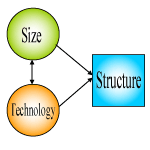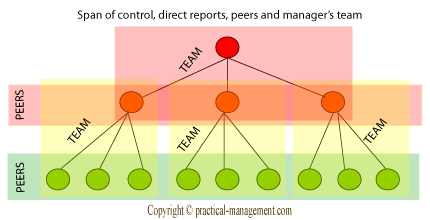Every organization strives for growth, thereby increasing the management's span of control. But how does the organization size influences the structure of an organization?
Organization’s size and span of control
Organization’s size is determined by number of its employees, the largeness of its operation, and its market reach and share. It also poses a very different challenge for the organization’s leaders, while small organizations are build for innovation, large are meant for operational efficiency. The skills necessary for entrepreneurship are quite different from that of running a large and diverse organization, large organizations requires more concern for people, controlling specialized departments and a talent for sensing issues buried deep in the organization.
Why organizations strive for growth?
- Better customer service: Organizations grow their revenue by increasing their customer base, as a consequence, the product and services need more changes and support. To serve the customer better, the organization has to employee more resources.
- Grow for survival: Small organizations are more easily affected by the sudden changes in the external environment; hence the business leaders feel compelled to grow or perish.
- Control more resources: Growth ensures that the organization has better control over the necessary external resources like raw material, skilled workers and technological advancement.
- Increase market share: Growth also ensures that the organization can compete globally, can penetrate new markets and can provide good service and influence customer loyalty.
- Deter competition: Big organization can invest in complex products, has means to control cost and can be aggressive in marketing strategies. All such measures result in stabilizing the market in long term and act as deterrent to new entrants.
- Diverse product lines: Having several products and technologies provides better market intelligence for new products and changing customer preferences. It ensures that while older products lose market share and turn out to be obsolete, the newer are in queue to replace them.
- Exciting employee opportunities: A growing organization provides exciting and vibrant work environment, better career growth opportunities and can attract best available brains. It should be noted that a growth is the stage of becoming large, once it has attained the large status, it may get stagnant and might only provide a long and stable career.
Characteristics of organizational size
- Technology required to produce the product is major determinant of size, an airplane, space shuttles, communication satellites, cable bridges, a sport stadium etc require technology that requires a large number of people. Consequently a large organization must be producing something that cannot be produced efficiently with smaller size; otherwise it indicates excessive cost & overhead and needs to be corrected. Hence both technology and size are interrelated and influence the structure of the organization.

- Amount of task specialization increases with size, the work design is focused and require individuals and teams to deliver a well defined quality of task.
- Management hierarchy grows with size: Increased size results in more specialization and decentralization of decision making, the tasks are delegated to teams and are managed by the lower level managers or supervisors. The span-of-control discussed later, makes it necessary to add more management layers for better control of resources and inter-organizational interactions.
- The rate at which the size influences the organizational structure decreases as the size increases, thus the impact of size increase in more in a small organization.
- Job satisfaction decreases as the size increases, more specialization and focused work design causes an increase in peer competition; thereby reduces the career growth opportunities.
Differences between large and small organizations
| Large | Small |
| Stabilizes market | Introduces competition |
| Produce complex task & products, has capital and resources to do so. | Produces innovative concepts & products |
| Predator of small firms, tends to acquire them. | Prey for large firms, get’s bought and since mergers are rarely successful, it finally gets dissolved. |
| Better resistance towards adverse external environmental changes. | Growth & existence is dependent on external environment. |
| Serves mass markets, tends to have global reach. | Serves niche customers and markets and strives to grow. |
What is Span of control?
The span of control refers to number of employees that directly report to a single manager. Span of control determines the structure of an organization, a narrow span of control results in hierarchal organization while broad span of control leads to flat structure.
Since management represents the activities that do not directly result in productivity, they are rather a overhead, span of control determines the additional operational cost. Quantitatively, companywide overhead can be calculated by dividing the total number of management staff with the size of organization.
Span of control formulation
What is an optimal ratio of manger to direct reports without compromising the productivity? It is a fundamental problem in designing the structure of an organization, empirically this range is pretty wide, from 4 to 22 depending upon the nature of work. In 1933, V. A. Graicunas, a paris based consultant formulated the span of control based on number of direct and indirect relationships that a superior has to manage. Graicunas identified three types of relationships:
- Number of direct relationships between manager and subordinate, it represents the span of control.
- Number of peer-to-peer relationships, it represent issues due to interpersonal conflicts. Note that each pair of peers represent 2 relationship and not 1, if there are two subordinates, dick and jane, dick might have different concern for jane than jane’s concern for dick. Hence for a manger, they represent 2 different set of problems and not one.
- Direct relationship between manager and subset of subordinates. Similar to previous peer-to-peer relationship, the manager “bill” will have to behave differently with dick when jane is also present.

Graicunas also formulated the minimum relationship in case where there was only one relationship between peer-peer or manager-subordinate subset cases, this occurs if each subordinate are provided independent task, minimizing their interactions. This however doesn’t undermine the role of a team, it is assumed that the manager is responsible for a project that is carried out by his team, but the subtasks are designed to minimize direct dependencies.
The following table demonstrates Graicunas formulation of span of control, its minimum and maximum cases and it also shows that relationship complexity increases tremendously as 5th or 6th subordinate is added.
| Direct | Cross | Group | Total |
| n (max) | n(n-1) | n(2n-1-1) | n(2n-1+n-1) |
| n ( min) | n/2(n-1) | 2n-n-1 | 2n+n/2(n-1)-1 |
| 4 | 12max, 6min | 28max,11min | 44max , 21min |
| 5 | 20max,10min | 75max , 26min | 100max, 41min |
| 6 | 30max,15min | 186max,57min | 1296max,78min |
Size and Structural Paradox
The reason why I have discussed span-of-control in the context of size is because it determines the level of hierarchy required to mange it. The table below demonstrates the relationship between the span of control, hierarchy and total number of employees (size).
| Hierarchy | 2 | 3 | 4 | 5 |
| Span of control | ||||
| 4 | 21 | 85 | 341 | 1365 |
| 5 | 31 | 156 | 781 | 3906 |
| 6 | 43 | 259 | 1555 | 9331 |
As an organization grows in size, it either needs more managers to control the productivity, thereby adding layers of management hierarchy, or it increases the span-of-control, increasing exponentially the management complexity. This paradox also questions the feasibility of horizontal organizations when the internal factors demand smaller span-of-control. Perhaps, in practicality, the organizations grow naturally into hierarchical organizations due to this paradox. Given a choice, the management will always tend to choose more control; it gives them the confidence and power.
This analysis also explains why employee/job satisfaction decreases as the size grows, hierarchical growth depletes employee empowerment while larger span-of-control simply makes the manager ineffective and the team situation chaotic.
Comparison of span-of-control
| Narrow Span | Broad Span |
| Close supervision & directed control. | Overloaded supervisors, loss of control. |
| Many levels of management, high cost of management staff. | Low management overhead, better operational cost and profit margins. |
| Less independence and decision authority for subordinates. | Encourages empowerment through delegation of authority and decision making. |
| Large distance between top management & bottom staff. Poor executive communication and visibility. | Employees have better communication with the top management. |
Factors influencing span-of-control
- Environmental Stability: When the external environment is more stable than dynamic, more employees can be supervised by a single manager. Stable environment is less demanding and reduces the need for quick response, thereby provide more flexibility in time and schedules.
- Nature of work: Routine jobs, tasks that require limited skills or are focused, require only occasional management decision and coaching, thus can have wider span of control. On the other hand, the tasks that are inherently complicated; loosely defined and require frequent decision making would require narrow span of control.
- Experience level: When the average job related experience of employees is high, they require little training or direction, the tasks can be easily delegated. Under such situations, span of control of managers can be increased.
- Budget Constraints: When an organization is facing financial hardship or is downsizing, it needs to increase the span of control. On the contrary, when an organization gets more investment, it tends to reduce the span and inflate it’s management.
Methods to maximize the span-of-control
- Information technology: Use of efficient communication tools like online wiki’s, videos, project management and tracking tools, and other decision support systems can reduce the overall relationship complexity, thereby encouraging managers to supervise more subordinates.
- More training: Investing in training the employees for the current job skills and also future skills makes them more independent. Constantly involving the employees in various trainings not only increases the collective intelligence within the organization but also results in readily available resource pool in-house.
- Work design: If the tasks are designed to be independent, loosely coupled with few interdependencies and probable conflicts, the relationship complexity can be reduced.
Controlling the size
- Identify and correct units with unbalanced/skewed ratios between supervisors and subordinates.
- Watch for narrowing of span of control over period of time, take corrective actions that might include restructuring, trainings or downsizing.
